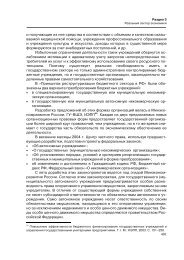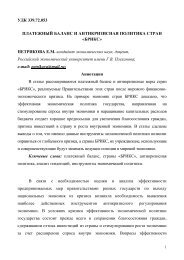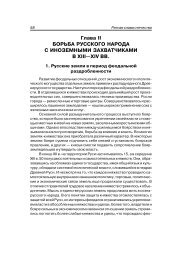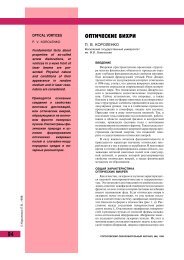Ensuring Strategic Stability in the Past and Present:
Ensuring Strategic Stability in the Past and Present:
Ensuring Strategic Stability in the Past and Present:
You also want an ePaper? Increase the reach of your titles
YUMPU automatically turns print PDFs into web optimized ePapers that Google loves.
Chapter 14: The Role of Imbalances on <strong>the</strong> Level of Conventional Forces <strong>and</strong>WeaponsAt lower nuclear weapon thresholds, <strong>the</strong> role of <strong>the</strong> imbalance <strong>in</strong> conventional weapons <strong>and</strong>forces, which is quite considerable <strong>the</strong>se days, <strong>in</strong>creases; <strong>and</strong> Russia will not benefit from thisimbalance. (One of <strong>the</strong> weighty components of this imbalance is <strong>the</strong> absolute dom<strong>in</strong>ation of <strong>the</strong>United States <strong>and</strong> its allies over <strong>the</strong> world’s oceans. We can deny such dom<strong>in</strong>ation only <strong>in</strong> someselected seas that we carefully choose. This was <strong>the</strong> focus of <strong>the</strong> formula that was once proposedby <strong>the</strong> author of this paper for <strong>the</strong> designation of a Nor<strong>the</strong>rn <strong>Strategic</strong> Bastion located <strong>in</strong> <strong>the</strong> Europeanpart of <strong>the</strong> Russian polar region <strong>and</strong> an Eastern <strong>Strategic</strong> Bastion located <strong>in</strong> a certa<strong>in</strong> area<strong>in</strong> <strong>the</strong> Pacific Ocean.)In <strong>the</strong> modern context, it is absolutely impossible to develop adequate formulas of strategic stabilitywithout tak<strong>in</strong>g <strong>the</strong>se imbalances <strong>in</strong>to consideration, whe<strong>the</strong>r <strong>the</strong>y be imbalances <strong>in</strong> strategicweapons, general-purpose forces, or conventional weapons. These imbalances must be consideredon a global basis (with due regard for <strong>the</strong> strategic mobility capabilities of <strong>the</strong> sides) or <strong>in</strong><strong>the</strong> context of particular <strong>the</strong>aters of military operations <strong>and</strong> regions, especially regions with highpolitical tensions. Recently, one of <strong>the</strong> most mean<strong>in</strong>gful threats aga<strong>in</strong>st general strategic stabilitywas <strong>the</strong> aggression of <strong>the</strong> pro-Western, pro-U.S. regime of Mikheil Saakashvili aga<strong>in</strong>st South Ossetia.This aggression was largely encouraged by <strong>the</strong> large-scale (on a scale of <strong>the</strong> South Caucasus<strong>and</strong> Transcaucasia) supply of weapons <strong>and</strong> military hardware to <strong>the</strong> Georgian armed forces <strong>and</strong><strong>the</strong> tra<strong>in</strong><strong>in</strong>g of Georgia’s military personnel. The prevention of such situations <strong>in</strong> <strong>the</strong> future is oneof <strong>the</strong> priorities associated with secur<strong>in</strong>g strategic stability; a priority that should be <strong>the</strong> subject ofRussia’s discussions of a new European security architecture with Western countries.As a result of rapid development (primarily <strong>in</strong> <strong>the</strong> United States) of high-precision long-range(<strong>in</strong>clud<strong>in</strong>g <strong>in</strong>tercont<strong>in</strong>ental) weapons <strong>in</strong> recent years, <strong>the</strong> issue of <strong>the</strong> vulnerability of various SNFcomponents to such weapons is becom<strong>in</strong>g <strong>in</strong>creas<strong>in</strong>gly topical. 114 This issue was on <strong>the</strong> agendaback <strong>in</strong> <strong>the</strong> 1980s, but nowadays it has reached a qualitatively new level that requires thorough<strong>and</strong> highly professional consideration <strong>in</strong> Russia from all po<strong>in</strong>ts of view—military-political, operational-strategic<strong>and</strong> military-technical. 115As mentioned above, nuclear weapons act as a sort of equalizer of <strong>the</strong> combat capabilities of <strong>the</strong>sides. 116 If <strong>the</strong> problems of limitation <strong>and</strong> reduction of nuclear weapons are to be taken seriously,we must also take combat capabilities <strong>in</strong>to consideration, tak<strong>in</strong>g account important nationalsecurity <strong>in</strong>terests, no matter how good <strong>the</strong> political relations may be. And we still do not see anycredible signs that <strong>the</strong> West is ready to elim<strong>in</strong>ate <strong>the</strong> imbalance <strong>in</strong> general-purpose forces <strong>and</strong>conventional weapons or add “non-offensive defense” formulas to its armory.In this context, U.S. appeals to pursue “absolute nuclear zero” <strong>in</strong> all countries look special, to putit mildly.56<strong>Ensur<strong>in</strong>g</strong> <strong>Strategic</strong> <strong>Stability</strong> <strong>in</strong> <strong>the</strong> <strong>Past</strong> <strong>and</strong> <strong>Present</strong>: Theoretical <strong>and</strong> Applied Questions
















